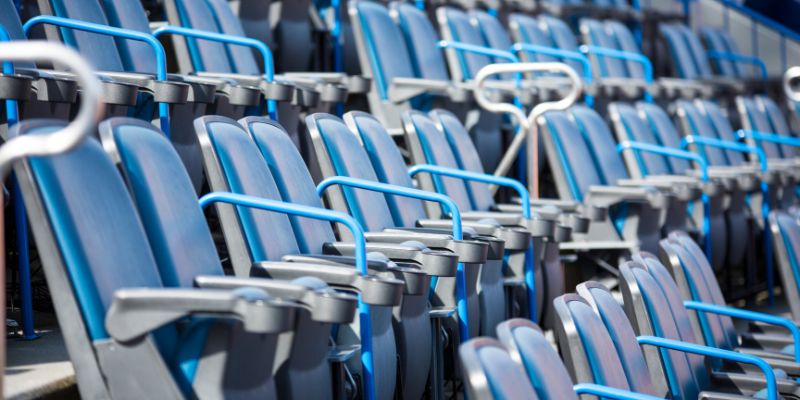There isn’t a ‘one size fits all’ rule for seating at sporting events. Some teams prefer to allow guests to choose their seats when they arrive at the stadium, while others prefer to sell assigned seats for their games. There’s even an in-between option where guests choose their section in advance but select their individual seats when they arrive.
To help you decide what’s right for your team, here’s a breakdown of the pros and cons of each type of admission.
General Admission
General admission can be a great option for smaller stadiums where you want to give your guests flexibility in where they sit. Maybe they’d rather not sit in the sun, so they choose seats in the shade. Or they’d prefer to sit their small children far away from a rowdy group of fans. With general admission, guests have the flexibility to do that.
General admission seating is simple to set up, and guests don’t have to do any extra work like selecting seats when purchasing tickets. Plus, guests won’t have to search for their seat numbers when they arrive.
There can be downsides, however. Even though every fan pays the same price for admission, they don’t all enjoy the same view of the field. They’ll need to show up early to snag the best seats, and some families might worry about finding seats together. You might also encounter fans trying to save seats for people who haven’t arrived at the stadium yet.
Pros:
- Simple to set up
- Simple to purchase tickets
- Flexibility for guests
Cons:
- All the seats cost the same no matter their location
- Missed revenue opportunities: there’s no upsells for premium seats
- Guests have to arrive early to get ‘the good seats’
- Less organized: seating is a free-for-all
- Can cause overbooking issues if you don’t control ticket inventory
- Guests may leave early if all that’s available is standing room
- Guests can’t always sit with their entire party
Assigned Seating
Assigned seating can be a great option for any size stadium, though the potential for increased revenue is higher with a larger stadium where seating makes a greater difference. Guests often appreciate the control over their experience that assigned seating affords them, as well as the convenience of just finding their seat and sitting down.
It is a more complicated set up for you as the organizer.
Pros:
- Convenience: guests can choose their seats in advance
- Guarantee everyone in a party can sit together if they purchase adjacent seats
- Ability to charge higher prices for premium seats
- More organized
- Eliminates the need for ‘seat saving’
- Lower risk of overbooking
- Great for season ticket holders: gives fans a sense of belonging when they sit in “their” seats every game
Cons:
- More complicated to set up*
- Longer checkout process
- Small chance guests won’t attend if they can’t get the seats they want
*Unless you have a concierge support team who will set everything up for you!
Sectional Seating
Sectional Seating is where guests purchase tickets for a specific zone or section of your stadium, but not the individual seats they will occupy. This seating strategy offers a great in-between solution if you’re looking for a little more control and organization than general admission while still taking advantage of some of the pros of assigned seating. Guests have some control over where they sit and how much they want to pay, and you can take advantage of the more revenue opportunities by charging different prices for each section.
Still, this type of seating isn’t right for everyone. Within premium sections especially, guests may still need to show up early to get their preferred seats and families may worry about sitting together even if they’re tickets are in the same section.
Pros:
- Greater organization than general admission
- Simpler set up than assigned seating
- Extra revenue potential: premium sections can come with a higher price point
- Gives guest some control over their view of the game and ticket price
Cons:
- Can cause overbooking if you don’t control the number of tickets sold in each section
- Seat saving, especially in premium sections
- Guests have to arrive early to get ‘the good seats’
- Guests may not be able to sit with their entire party if a section is full
Bringing It Home
Ultimately, whatever ticketing option you choose, it’s important to ensure that it’s a good fit for both you and your guests. Any of these solutions can work with any size stadium, though there is potential for missed revenue opportunities.
It’s also important to ensure your ticketing provider offers an option that suits your team the best. If not, maybe it’s time to check out Passage - a ticketing platform built with features made for sports teams. *Spoiler alert* We offer general admission, assigned seating, and sectional seating options and we’ll do all the heavy lifting when it comes to setting up your ticketing page.
Schedule some time with one of our event experts who can help you find the right ticketing setup for your sports team.

.jpg?width=800&height=400&name=Assigned%20Seating%20vs%20General%20Admission%20(1).jpg)
.jpg?width=800&height=400&name=Assigned%20Seating%20vs%20General%20Admission%20(2).jpg)









